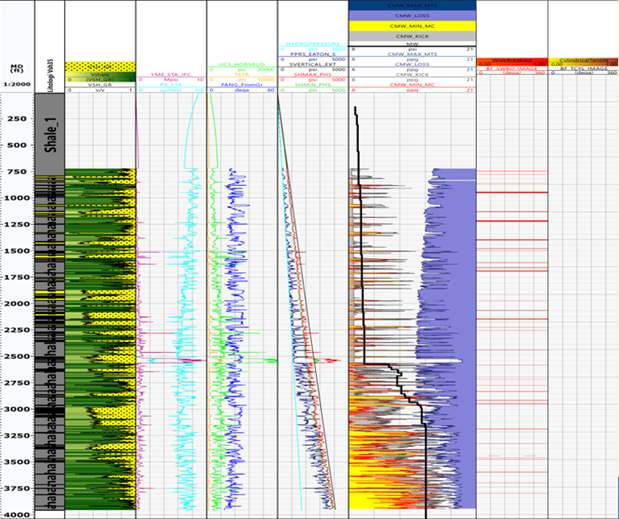1D Geomechanical Model For Wellbore Stability in Z Field, Y Well Sanga Sanga Working Area, Kutai Basin
DOI:
https://doi.org/10.25299/jgeet.2023.8.02-2.13871Keywords:
Wellbore Stability, Drilling Mud Weight, Failure, Stress, Pore Pressure, Rock Strength, Rock ElasticAbstract
This research is about 1D geomechanical model for wellbore stability in Z Field, Y Well Sanga Sanga Working Area, Kutai Basin where wells have been drilled. The Purpose of this Research is to analyze the stability of the well starting from knowing the stress regime that occurs, predicting the occurrence of wellbore failure, and determining safe mud weight window for next drilling. The method use in this Research is a numerical modelling method using log data and drilling data that has been obtained and then managed using Techlog Software. The result of this Research show the magnitude of mechanical properties of the rock that have been obtained, then in general the stress regime that occurs in the Z Field formation is the normal regime even though the strike slip and reverse regime are inserted at a certain depth, then based on the prediction results of failure in this well is wide breakout, which in general occurs in lithology with sandstone, finaly safe mud weight window can be estimated properly, so that it can be used for further well drilling. This research is about 1D geomechanical model for wellbore stability in Z Field, Y Well Sanga Sanga Working Area, Kutai Basin where wells have been drilled. The Purpose of this Research is to analyze the stability of the well starting from knowing the value of the mechanical properties of the formation, the stress regime that occurs, predicting the occurrence of wellbore failure, and determining safe mud weight window for next drilling. The method use in this Research is a numerical modelling method using log data and drilling data that has been obtained and then managed using Techlog Software. The result of this Research show the magnitude of mechanical properties of the rock that have been obtained, then in general the stress regime that occurs in the Z Field formation is the normal regime even though the strike slip and reverse regime are inserted at a certain depth, then based on the prediction results of failure in this well is wide breakout, which in general occurs in lithology with sandstone, finaly safe mud weight window can be estimated properly, so that it can be used for further well drilling.
Downloads
References
Albukhari, T.M., Beshish, G.K., Abouzbeda, M.M. and Madi, A.B.D.A.S.A.L.A.M., 2018, March. Geomechanical wellbore stability analysis for the reservoir section in JNC186 oil field. In ISRM 1st International Conference on Advances in Rock Mechanics-TuniRock 2018. OnePetro.
BPPKA, P., 1997. Petroleum Geology of Indonesia Basins: Principles, Methods, and Applications, Vol. X South Sumatra Basins.
Darvishpour, A., Seifabad, M.C., Wood, D.A. and Ghorbani, H., 2019. Wellbore stability analysis to determine the safe mud weight window for sandstone layers. Petroleum Exploration and Development, 46(5), 1031-1038.
Eaton, B.A., 1975, September. The equation for geopressure prediction from well logs. In Fall meeting of the Society of Petroleum Engineers of AIME. OnePetro.
Fjaer, E., Holt, R.M., Horsrud, P. and Raaen, A.M., 2008. Petroleum related rock mechanics. Elsevier.
Kang, Y., Yu, M., Miska, S. and Takach, N.E., 2009, October. Wellbore stability: A critical review and introduction to DEM. In SPE Annual Technical Conference and Exhibition. OnePetro.
Pašić, B., Gaurina Međimurec, N. and Matanović, D., 2007. Wellbore instability: causes and consequences. Rudarsko-geološko-naftni zbornik, 19(1), 87-98.
Paul, S., Chatterjee, R. and Kundan, A., 2009. Estimation of Pore Pressure Gradient and Fracture Gradient from Well Logs: A theoretical analysis of techniques in use. In International Oil & Gas Review Symposium, Mumbai, India.
Plumb, R., Edwards, S., Pidcock, G., Lee, D. and Stacey, B., 2000, February. The mechanical earth model concept and its application to high-risk well construction projects. In IADC/SPE Drilling Conference. OnePetro.
Satyana, A.H., Nugroho, D. and Surantoko, I., 1999. Tectonic controls on the hydrocarbon habitats of the Barito, Kutei, and Tarakan Basins, Eastern Kalimantan, Indonesia: major dissimilarities in adjoining basins. Journal of Asian Earth Sciences, 17(1-2), 99-122.
Supriatna, S., Sudrajat, A. and Abidin, H.Z., 1995. Geological Map of The Muara Teweh Quadrangle Kalimantan. Geological Research and Development Centre, Bandung.
Swarbrick, R.E., Osborne, M.J. and Yardley, G.S., 2001. AAPG Memoir 76, Chapter 1: Comparision of Overpressure Magnitude Resulting from the Main Generating Mechanisms.
Syarifuddin, N. and Busono, I., 1999. Regional stress alignments in the Kutai Basin, East Kalimantan, Indonesia: a contribution from a borehole breakout study. Journal of Asian Earth Sciences, 17(1-2), 123-135.
Wu, Y., Patel, H., Salehi, S. and Mokhtari, M., 2020. Experimental and finite element modelling evaluation of cement integrity under diametric compression. Journal of Petroleum Science and Engineering, 188, 106844.
Zain-Ul-Abedin, M. and Henk, A., 2020. Building 1D and 3D mechanical earth models for underground gas storage—A case study from the Molasse Basin, Southern Germany. Energies, 13(21), 5722.
Zoback, M.D., 2007. Reservoir geomechanics. Cambridge university press.

Downloads
Published
Issue
Section
License
Copyright @2019. This is an open-access article distributed under the terms of the Creative Commons Attribution-ShareAlike 4.0 International License which permits unrestricted use, distribution, and reproduction in any medium. Copyrights of all materials published in JGEET are freely available without charge to users or / institution. Users are allowed to read, download, copy, distribute, search, or link to full-text articles in this journal without asking by giving appropriate credit, provide a link to the license, and indicate if changes were made. All of the remix, transform, or build upon the material must distribute the contributions under the same license as the original.










